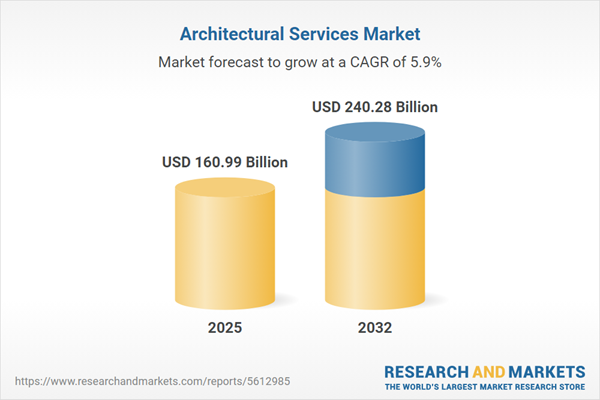Speak directly to the analyst to clarify any post sales queries you may have.
The architectural services market is undergoing rapid change, shaped by digital advancements, regulatory forces, and new demands for sustainable built environments. Senior leaders in the sector must navigate increasingly complex compliance, technology, and client requirements to ensure consistent value delivery and business resilience.
Market Snapshot: Architectural Services Market Overview
The Architectural Services Market grew from USD 152.19 billion in 2024 to USD 160.99 billion in 2025. This sector is projected to increase at a CAGR of 5.87%, achieving USD 240.28 billion by 2032. This surge is fueled by ongoing digital transformation, innovative design practices, and escalating focus on sustainability and regulatory compliance. The primary keyword architectural services market is central to these shifts, as industry players adjust to new project management approaches, evolving client expectations, and more rigorous environmental standards.
Scope & Segmentation
This market research provides a detailed assessment across a range of core segments, regions, and emerging technologies:
- Service Types: Building code compliance, consulting, design, and project management services.
- Construction Types: Landscape architecture, new constructions, renovations, and remodeling projects.
- Technology Adoption: Building Information Modeling (BIM), smart building systems, and sustainable architecture practices such as green roofs and passive solar solutions.
- Design Styles: Eclectic, modern (including minimalism, mid-century), and traditional (colonial, Tudor, Victorian) styles.
- End-User Industries: Commercial buildings (offices, retail, hospitality), industrial facilities (manufacturing, warehousing), institutional clients (healthcare, education, government), and residential projects.
- Regional Coverage: Key geographic markets include the Americas (North and Latin America), Europe, Middle East & Africa (EMEA), and Asia-Pacific (APAC) regions, with in-depth analysis for countries such as the United States, Canada, China, India, Germany, the United Kingdom, Japan, and Australia.
- Leading Companies: Coverage includes top firms such as AECOM, Arcadis N.V., Gensler, Foster + Partners, HDR, Stantec Inc., Worley Limited, Jacobs Solutions, and Perkins and Will, among others.
Key Takeaways for Senior Decision-Makers
- Digital collaboration platforms and advanced visualization tools are now pivotal in streamlining architectural workflows and facilitating real-time stakeholder engagement.
- Sustainability is core to client demands, intensifying the need for lifecycle analysis, green building certifications, and advisory expertise in passive design and materials selection.
- Expanding service portfolios into areas like remediation planning and adaptive reuse has emerged as a differentiator for firms aiming to address cultural heritage projects and regulatory constraints.
- Partnering with technology vendors and engineering specialists enhances the integration of smart systems, driving operational savings and improved occupant experiences.
- Industry consolidation, along with cross-border alliances, enables leading companies to benefit from local market knowledge and accelerated project approvals in diverse regulatory landscapes.
- There is a significant competitive advantage for firms cultivating innovation-driven cultures, where ideation workshops and knowledge-sharing foster rapid problem-solving to meet evolving needs.
Tariff Impact: Strategic Response to United States Tariff Policies
Recent shifts in United States tariff policies, notably on critical materials such as steel and aluminum, have introduced complexities to procurement and project execution. Firms are responding by turning to regional suppliers, incorporating hybrid material solutions, and embedding contingency planning within budgets and schedules. These adaptations support both cost management and alignment with sustainability objectives, as lifecycle cost considerations and energy-efficient materials become central in client discussions.
Methodology & Data Sources
This research applies a mixed-method approach by synthesizing findings from desk research, industry publications, regulatory documents, and direct interviews with architects, project managers, and procurement experts. Quantitative data are validated with regional development metrics, and findings are reinforced through expert roundtables and continuous engagement with domain professionals to ensure accuracy, depth, and relevance.
Why This Report Matters
- It equips executives and business development leaders with comprehensive insights into segmentation, regional opportunities, and emerging service models.
- Stakeholders gain actionable intelligence to navigate trade policy, technology disruption, and sustainability shifts in the architectural services market.
- The analysis supports informed investment decisions, risk management, and the design of differentiated growth strategies aligned to client and regulatory expectations.
Conclusion
The architectural services landscape is being redefined by the intersection of innovation, sustainability, and global collaboration. Leaders with a proactive approach to digital integration, supply chain diversification, and adaptive service delivery are best positioned to capture market opportunities. This report provides senior decision-makers with the clarity to chart sustainable growth amid ongoing sector transformation.
Additional Product Information:
- Purchase of this report includes 1 year online access with quarterly updates.
- This report can be updated on request. Please contact our Customer Experience team using the Ask a Question widget on our website.
Table of Contents
3. Executive Summary
4. Market Overview
7. Cumulative Impact of Artificial Intelligence 2025
Companies Mentioned
The companies profiled in this Architectural Services market report include:- AECOM
- Aedas
- Arcadis N.V.
- Australian Design & Drafting Services company
- Bechtel Corporation
- BluEntCAD
- Cannon Design Inc.
- DP Architects Pte Ltd.
- Excel Project Solutions LLC
- Fluor Corporation
- Foster + Partners Group Limited
- Gensler. M. Arthur Gensler Jr. & Associates, Inc.
- Hardlines Design Company
- HDR, Inc.
- HKS Inc.
- HOK Group, Inc.
- Jacobs Solutions Inc.
- MBH Architects
- Mott MacDonald
- Nikken Sekkei Ltd.
- PCL Constructors Inc.
- Perkins and Will, Inc.
- Stantec Inc.
- Worley Limited
- WSP Global Inc.
Table Information
| Report Attribute | Details |
|---|---|
| No. of Pages | 181 |
| Published | November 2025 |
| Forecast Period | 2025 - 2032 |
| Estimated Market Value ( USD | $ 160.99 Billion |
| Forecasted Market Value ( USD | $ 240.28 Billion |
| Compound Annual Growth Rate | 5.8% |
| Regions Covered | Global |
| No. of Companies Mentioned | 26 |









